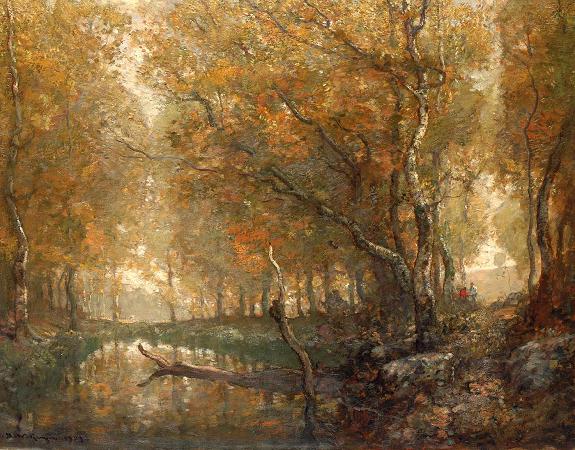Landscape with Pond. A pond is an area filled with water, either natural or artificial, that is smaller than a lake. Defining them to be less than 5 hectares in area, less than 5 meters deep, and with less than 30% emergent vegetation helps in distinguishing their ecology from that of lakes and wetlands. Ponds can be created by a wide variety of natural processes, or they can simply be isolated depressions filled by runoff, groundwater, or precipitation, or all three of these. They can be further divided into four zones: vegetation zone, open water, bottom mud and surface film. The size and depth of ponds often varies greatly with the time of year; many ponds are produced by spring flooding from rivers. Ponds may be freshwater or brackish in nature. 'Ponds' with saltwater, with a direct connection to the sea that maintains full salinity, would normally be regarded as part of the marine environment because they would not support fresh or brackish water organisms, so not really within the realm of freshwater science. Ponds are usually by definition quite shallow water bodies with varying abundances of aquatic plants and animals. Depth, seasonal water level variations, nutrients fluxes, amount of light reaching the ponds, the shape, the presence of visiting large mammals, the composition of any fish communities and salinity can all affect the types of plant and animal communities present. Food webs are based both on free-floating algae and upon aquatic plants. There is usually a diverse array of aquatic life, with a few examples including algae, snails, fish, beetles, water bugs, frogs, turtles, otters and muskrats. Top predators may include large fish, herons, or alligators. Since fish are a major predator upon amphibian larvae, ponds that dry up each year, thereby killing resident fish, provide important refugia for amphibian breeding. Ponds that dry up completely each year are often known as vernal pools. Some ponds are produced by animal activity, including alligator holes and beaver ponds, and these add important diversity to landscapes. Ponds are frequently manmade or expanded beyond their original depths and bounds by anthropogenic causes. Apart from their role as highly biodiverse, fundamentally natural, freshwater ecosystems ponds have had, and still have, many uses, including providing water for agriculture, livestock and communities, aiding in habitat restoration, serving as breeding grounds for local and migrating species, decorative components of landscape architecture, flood control basins, general urbanization, interception basins for pollutants and sources and sinks of greenhouse gases. The technical distinction between a pond and a lake has not been universally standardized. Limnologists and freshwater biologists have proposed formal definitions for pond, in part to include 'bodies of water where light penetrates to the bottom of the waterbody, bodies of water shallow enough for rooted water plants to grow throughout,' and 'bodies of water which lack wave action on the shoreline.' Each of these definitions are difficult to measure or verify in practice and are of limited practical use, and are mostly not now used. Accordingly, some organizations and researchers have settled on technical definitions of pond and lake that rely on size alone. Some regions of the United States define a pond as a body of water with a surface area of less than 10 acres. Minnesota, known as the land of 10,000 lakes, is commonly said to distinguish lakes from ponds, bogs and other water features by this definition, but also says that a lake is distinguished primarily by wave action reaching the shore. Even among organizations and researchers who distinguish lakes from ponds by size alone, there is no universally recognized standard for the maximum size of a pond. The international Ramsar wetland convention sets the upper limit for pond size as 8 hectares. Researchers for the British charity Pond Conservation have defined a pond to be 'a man-made or natural waterbody that is between 1 m 2 and 20,000 m 2 in area, which holds water for four months of the year or more.' Other European biologists have set the upper size limit at 5 hectares. In North America, even larger bodies of water have been called ponds; for example, Crystal Lake at 33 acres, Walden Pond in Concord, Massachusetts at 61 acres, and nearby Spot Pond at 340 acres. There are numerous examples in other states, where bodies of water less than 10 acres are being called lakes. As the case of Crystal Lake shows, marketing purposes can sometimes be the driving factor behind the categorization. In practice, a body of water is called a pond or a lake on an individual basis, as conventions change from place to place and over time. In origin, a pond is a variant form of the word pound, meaning a confining enclosure.
more...














